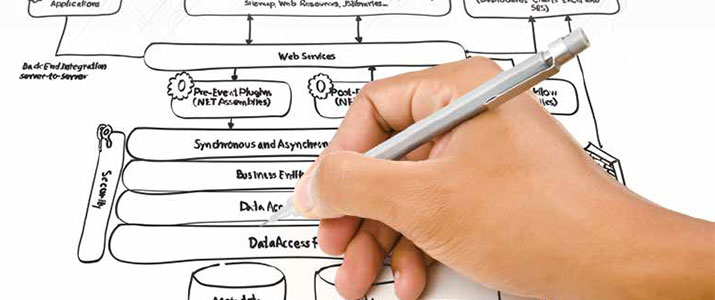
Using the Network for Security
Is a retrofit security solution the answer?
- By Kim Rahfaldt
- Aug 01, 2013
 Joe from ABC Company has had the same
security management system for 15 years in
all of his buildings. He likes it; he knows it inside
and out, and he can give training classes
to his security guards on how to use it.
Joe from ABC Company has had the same
security management system for 15 years in
all of his buildings. He likes it; he knows it inside
and out, and he can give training classes
to his security guards on how to use it.
Today, however, Joe’s integrator called to tell
him that the access control manufacturer has
announced that ABC Company’s system is at
the end of its life. They will no longer manufacture the product
and, soon after, will stop supporting it.
As the shock settles in, Joe begins to analyze his situation. In
reality, the company is starting to outgrow its system from a technology
standpoint, but he is comfortable with the system, and a
lot of time and money has been invested into it.
The maintenance and upgrade costs, although high, were expected
and budgeted. However, he soon analyzed that the system
had actually been costing him money over the past five years.
Joe has a decision to make.
What is the next step? Rip out the existing system and start
over? Start down a lengthy, labor-intensive, upgrade path? Both
options are time consuming, expensive and full of unknown issues,
and neither solution was appealing to management or other
stakeholders.
Luckily, Joe has been hearing about retrofit solutions at recent
tradeshows. These types of solutions offer all the benefits
of a new system while avoiding a high cost, labor intensive, disruptive
upgrade.
Maybe it’s time to consider a retrofit solution.
Provides All the Benefits
without the Drawbacks
Many worldwide end users have recently learned their long-time,
networked, security management systems are facing one or more of these dilemmas:
- The product being used is discontinued, due to an end-of-life
scenario.
- The system has become antiquated and doesn’t meet the needs
of the company any longer.
- The company has outgrown the system, and it can no longer
expand to meet the growth requirements.
- Expensive, risky, labor-intensive upgrade nightmares are on
the horizon.
Starting over means spending months researching new products
and their capabilities as well as investigating new manufacturers,
while embarking on the path of an upgrade is equally time
consuming and could have unforeseen pitfalls and costs. Both
solutions mean finding money in the budget.
The alternative is installing a security management system with
hardware, software and processes designed specifically for retrofit
situations. A retrofit solution allows a company to upgrade quickly,
easily and affordably while protecting their current investment.
When a company chooses the correct retrofit solution, it can
reuse a large portion of its existing network infrastructure, such
as enclosures, hardware and wiring, along with other components
like readers, badges and other field hardware. Reusing provides
a huge cost savings for the end user and time savings for the end
user and integrator. The drastic reduction in downtime minimizes
impact on the business.
How to Choose the Right Retrofit System
End users can avoid the lengthy, complicated, expensive upgrade
process when they choose the right retrofit security solution.
Some retrofit solutions require multiple updates to software and
complicated hardware analysis to determine viability. Not all retrofit
solutions provide the same ease of use and plug-and-play
functionality.
To choose the best retrofit system, look for a solution where
the circuit board drops into the existing controller chassis. This
allows the installer to simply unplug the old circuit board, and
replace it with the new one. New boards should slide into the
existing card cage, and connectors should fit the new controllers
seamlessly, without the use of tools. Power can then be turned
back on, and the new system should be operational within minutes
per controller.
Choose a Trustworthy Company
Changing security systems is a stressful process, but when an end
user does their homework and chooses a trust-worthy manufacturer
with a history of stability, the transition can go smoothly.
There are several factors that help determine which manufacturer
to choose.
Product development. Does the manufacturer control the
product development? Many manufacturers OEM products and
sell them as their own, and while this is perfectly acceptable in the
security industry, it means the manufacturer does not control inhouse
product development.
When a company chooses a manufacturer, they should examine
its product development process. It’s much more beneficial
to choose a manufacturer that completely controls all product
development in-house, including hardware, software and firmware,
because upgrades to their products can be done quicker
and easier than companies that OEM their products. (Upgrades
ensure optimum product performance within the system and with
any third-party integrations).
Backward compatibility. Choose a manufacturer that offers a
guaranteed, backward compatibility promise for its products. As
companies develop new products, they should always work seamlessly
with older products to protect end user investment(s) and
eliminate expensive upgrades.
Scalability. Research how a manufacturer’s products work
together. Then, choose one that offers flexible, scalable and upwardly
mobile solutions to ensure the system can grow with the
company as it adds to the retrofit security system.
Ease of use. Find a system with intuitive software offering the
same GUI for all products. This makes upgrading easier, because
the security staff is familiar with the product. Some manufacturers
even make software that has a similar look and feel as Microsoft
Office. It doesn’t get more familiar than that.
Exceptional customer service. Pay close attention to the customer
service provided during initial discussions, presentations
and site visits. Who is making the presentations? Is that person
listening to the end users’ specific needs? How is the follow
up? Has the end user met the manufacturer’s president or vice
president(s)?
Personal relationships, and the effort that goes into forging
them, can set a manufacturer apart. If a high-end executive flies
out to meet the end user, that speaks volumes about the manufacturer’s
customer service and personal investment in the project.
It shows the end user they are important and their business matters.
It also establishes a relationship with the high-level executive
team, and the end user knows they can pick up the phone and call
the president or vice president(s), knowing he or she will actually
take the call.
Establishing a relationship between the end user and the president
alone can help an end user make its decision on which system
to install.
Do the Homework
It’s important to take time to examine tomorrow’s needs today
to predetermine what security features and integrations may be
needed in the next three to 10 years.
Doing this homework upfront will help determine the type
of retrofit system to choose, ensuring the system offers deeplyintegrated
physical and logical access control, IP video, intrusion
detection, alarm management, badging and visitor management.
Some access control manufacturers build many of these features
into their base offering, providing a cost-effective solution for end
users to grow into. (Buyer beware: some manufactures offering a
base access control product charge additionally for each feature
module, like visitor management or intrusion).
Be sure to ask for references when calling or visiting the
manufacturer to determine its service track record. Investing in
a retrofit solution means entering into a new, long-term partnership
with that manufacturer; so, is the manufacturer likely to
provide exceptional customer service at all times based on the
references’ responses?
When an end user invests in a security management system,
it’s critical that the system capabilities are leveraged to their fullest
potential and that a maximum ROI is experienced. A good
professional services department fosters a teamwork approach
that brings the end user, integrator and manufacturer together
to provide specialized expertise to ensure this is met. Does the
manufacturer offer professional services assistance?
A lifecycle-management technical advisor helps manage the end user’s retrofit system by:
- ensuring the current software is always up-to-date;
- making sure the end user is using new features;
- planning for unique system variables;
- confirming system requirements meet retrofit requirements for
optimum results; and
- protecting data.
Does the manufacturer have a lifecycle management program
to support the end user every step of the way throughout the retrofit
path?
Finally, look for companies that have ISO 9001, ISO 14000,
ISO 27000, RoHS, UL294 compliance and a CE certification.
Does the manufacturer take pride in its products and maintain
the proper certifications and compliances?
What are the End User’s Needs?
As the end user transitions from the idea of installing a retrofit
security management solution to taking action, they need to
make sure the chosen system is a reliable solution that has the
feature set necessary to meet their needs including ease of use, an
intuitive system that reduces training time and a cost-effective,
scalable system that can grow as needed.
It can take a while to transition the old, obsolete system to
the new retrofit solution. The end user usually cannot afford to
shut down its security system for long periods of time, if at all,
so the manufacturer must work with the integrator to ensure a
smooth transition with no downtime. This is easily accomplished
by choosing a low-risk, easy-to-install, plug-and-play retrofit solution
that can operate alongside the old system.
At the end of the day, end users are looking for a trusted,
long-term partnership with a manufacturer, where the manufacturer
backs its system with quality products, provides exceptional
customer service and believes in establishing and maintaining
relationships.
Plug-and-Play Retrofit Solutions
While several retrofit security management systems are available,
end users need to consider the installation process as they migrate
to their new, networked system.
The best solutions on the market tend to offer a simple, circuit
board replacement. The end user can reuse existing enclosures,
fitting the same wall space without the need for additional real
estate or new boxes. Simply change out the boards as all wiring
infrastructure remains intact, eliminating the labor expense to remove
and install new wiring. And, the backplane operates flawlessly
with the existing wiring.
The system should support all existing communications topologies
of the legacy system, including downstream controllers
where multiple access control panels communicate with the host
software through one Ethernet port. This should be supported
through a plug-and-play procedure, with dial-up support also being
a possible requirement.
The end user can use its existing reader infrastructure by
choosing a retrofit system that supports legacy reader communication
protocols, including proprietary protocols like F/2F. This
allows the retrofit to leave existing readers (and badges) in place,
greatly reducing the time, cost and disruption of a replacement.
The manufacturer should provide a support team to identify
and plan the entire migration to minimize downtime and duplication
of effort by being available to help with conversions and
assist the end user every step of the way.
While many suppliers can assist with the conversion of cardholder
data, it is recommended to investigate what else can be
ported to the new system. Some suppliers can convert other information,
such as access rights, greatly reducing the manual effort
involved during the conversion. Don’t just consider database
conversion as a yes or no question, but make sure the specifics are
understood and agreed upon before committing.
When an end user chooses the right retrofit solution, they receive
a new, state-of-the-art, hardware and software platform that
meets their requirements, upgrades their system to modern technological
standards, eliminates risk, protects current investments
and reduces costs.
So, if you were Joe from ABC Company, what would you
choose?
This article originally appeared in the August 2013 issue of Security Today.